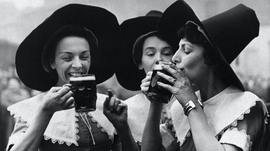In early March, The Conversation caught the internet’s attention with a story about alewives—female ale brewers in the 14th to 17th centuries who often owned alehouses, before the process of ale-making was industrialized. The story claimed that some classic witch iconography, such as black hats, was based on the garb of alewives, and that women were driven from the brewing profession due to accusations of witchcraft. However, Smithsonian Magazine later added an editor's note to their re-publication of the story, pointing out that historians disagreed with certain parts of it. So what is the truth about women brewers? Were they really pushed out of the brewing industry due to discrimination? Were witch’s wardrobes really based on their clothing?
The history of women and brewing goes back a long way. The earliest fermented beverage, a mixture of fruit, honey and rice, is dated to around 7000 to 5700 B.C.E. It was discovered in what is now Jiahu, China, and evidence suggests that the beverage was created by women. In fact, for thousands of years, women were the ones to gather ingredients for and brew fermented drinks while men hunted. Even some mythology recognized women’s part in producing beverages like beer. In Slavic and Baltic myths, the goddess Raugutiene divinely protected all beer. Ale, a low-alcohol drink that was often safer to drink than water due to fermentation killing off bacteria, was also brewed by European women for centuries.
However, the 1600s saw a rise in religious persecution of women in England and Germany, with thousands being killed for supposed witchcraft. At the same time, Europe was becoming increasingly industrialized. Home-brewing and small alehouses run by local alewives gave way to larger taverns, and men began stepping in to replace women, and make money. Depictions of alewives in literature and art became more negative. Some historians believe that there may be a connection between anti-witch propaganda and the sidelining of alewives–after all, alewives did wear large black hats, stir pots of frothing liquid, and hang brooms outside their doors to indicate that drinks were available. Other historians, however, say that depictions of witches as black-hat-wearing broomstick-riders didn’t appear until the 18th Century, long after most European women had stopped brewing. What’s known for sure, however, is that women brewers played an important and often-overlooked role in history. All hail the alewives!
Thanks for the story, Curio..


Enjoy being online again!
Welcome to the community of good people who base their values on evidence and appreciate civil discourse - the social network you will enjoy.Create your free account
3 comments
Feel free to reply to any comment by clicking the "Reply" button.“Eye of newt, and toe of frog, Wool of bat, and tongue of dog, Adder's fork, and blind-worm's sting, Lizard's leg, and owlet's wing,— For a charm of powerful trouble, Like a hell-broth boil and bubble. Double, double toil and trouble; Fire burn, and caldron bubble.” ― William Shakespeare
Enjoy being online again!
Welcome to the community of good people who base their values on evidence and appreciate civil discourse - the social network you will enjoy.Create your free account
Share this post
Categories
Agnostic does not evaluate or guarantee the accuracy of any content. Read full disclaimer.








